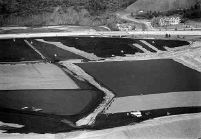Kellogg still strives to get the
lead out
It's no longer 'dirtiest town in
America,'
but many disagree on how bad it
is now
By Ken Miller
The Idaho Statesman
 |
| Kim Hughes |
| This site in Kellogg is the Bunker Hill central impoundment
area. |
 |
| Kim Hughes |
| Jerry Cobb of the Panhandle Health District has spent most of
his career working on the Bunker Hill cleanup. |
 |
|
| These are images from a cartoon book created by the Panhandle
Health District help children understand the dangers of lead poisoning. |
 |
|
|
Nobody knows better than Jerry Cobb why this town once drew reporters
like flies to poke around "the dirtiest town in America."
A quarter of a century ago, Kellogg was as contaminated as a town can
get. It had just been blanketed with deadly lead. Its children were in
danger.
During the past 25 years, much of the threat has been cleaned up, government
officials say. Some local activists disagree, arguing that Kellogg is better
off than it was in the 1970s but still is a disaster area.
"You've got to remember, this is a 100-year-old mining community," said
Cobb, who as environmental health supervisor for the Panhandle Health District
has been working on the Bunker Hill cleanup most of his career. "Most of
what was done here was completely legal.
"The other thing is, this is a really proud community. It was branded
'the dirtiest town in America,' and it got hammered by the press. From
what I've seen, it's just been a large intrusion in their lives. They want
it over, and they want to get on with it."
Kellogg is home to what used to be the Bunker Hill smelter, now known
by the federal Environmental Protection Agency as the Bunker Hill Mining
and Metallurgical Superfund Site.
In 1973, a fire broke out in the "baghouse" building of the local smelter.
That building filtered much of the contaminants from the smelter and captured
them for disposal. But when the building and its filters were damaged,
1,000 tons of particulate lead were dumped onto Kellogg and nearby communities
in about 12 months. That's the equivalent of between seven and 20 years
worth of lead emissions from the smelter poured out onto a town of about
2,300 people in a single year.
The disaster was unprecedented in Idaho. It also changed Cobb's life.
A year later, Cobb received a call from a local doctor who had a very
sick child on his hands. The doctor feared the child's symptoms reflected
those of lead poisoning and asked Cobb to help investigate the child's
home.
"We found high levels in the soils," he said. A full epidemiological
study was ordered. His office, state environmental health experts, and
the federal Centers for Disease Control and Prevention were shocked at
what they found. Lead levels in area children, in the soil, and in the
dust in homes were in some cases twice as high as federal standards --
or higher.
"This was a big plant," Cobb said. "It produced 25 to 30 percent of
the lead used in the country." The smelter's owner, Gulf USA Corp. (no
relation to the oil company), closed the plant in 1981, a full eight years
after the disaster that poisoned the community. In 1983, the EPA listed
a 21-square-mile area around Kellogg known as the "box" -- one of the nation's
most notorious Superfund sites.
"Superfund was new at the time," Cobb said of the national environmental
cleanup program that Congress enacted in 1980. He submitted a proposal
to run detailed blood-lead screenings on the local children, but admitted
thinking at the time, "This is going to be a long, drawn-out process."
He was right.
In the early 1980s, when Gulf shut the smelter down, Kellogg was reeling.
Mine workers fled for jobs in other communities, families broke apart as
the bread-winners went looking for a paycheck, often leaving spouses and
children behind. Local schools lost a third of their students. The town's
assessed property value dropped from $1.3 billion to $450 million. Shoshone
County was drained of its ability to cope with its mounting health crises.
"Heaped on EPA's coming in to turn the town into a Superfund site, there
was a lot of emotion, a lot of stress," Cobb said. "There was no money
for schools, and there was the sociological side. This has been a proud
community, a community that carried us through two world wars. They were
just in shock, and they get turned into a largely unemployed community.
...
"A million dollars hit the street every Friday just from Bunker Hill
alone," Cobb recalled. "When Bunker closed, people were absolutely in shock."
Year after year, local children had their blood tested. The results
were disturbing: Many of the children had lead levels that far exceeded
federal targets. Eventually, after the smelter closed, those levels began
to fall off. Most of the improvements came long before residential yards
were dug up and replaced with clean soil.
"Blood leads have definitely declined," Cobb said of the improvement
in lead contamination among children. Inside the Kellogg Superfund site,
the percentage of children meeting federal lead standards is just short
of the national goal, according to the most recent report, in April.
The Kellogg cleanup isn't without its critics.
Barbara Miller, director of the People's Action Coalition and a native
of nearby Cataldo, denied that the town is almost ready to removed from
the Superfund list.
"The simple issue here is, there is a huge pollution problem," Miller
said. "There is more lead in the homes than in the yards they are remediating."
Miller and other local activists say state and federal cleanup experts
haven't done enough to reduce the health threat from other pollutants,
such as cadmium, arsenic, zinc and mercury.
"It's not cleaned up," she said. "It's got the mining companies off
of any obligation for cleanup in the future, but it's still not cleaned
up. There is far more that needs to be done.
"Is there a stigma with us being a Superfund site?" she asked. "Perhaps.
But we have the opportunity to work with the EPA to remove that stigma
and make it better than before. No one is blaming anyone here; there's
just a need to have it taken care of and stopped."
Tracy Cannaday, a security guard from nearby Pinehurst, agreed.
"It took 100 years for this to happen," Cannaday said. "They're not
going to clean it up in 10 years or five years, or whatever. In the case
of Bunker Hill, we know the cleanup has been inadequate. The bottom line
is, kids are getting lead poisoning.
"I feel that in 30 years, it will still be too early to take the EPA
out of here," he said. "People here do realize the extent of the problem.
It's just that the special interests and the mining companies have refused
to realize it. There are people outside the Silver Valley who know more
about lead and contamination here than the people in the Silver Valley."
Cannaday recalls stringing barbed-wire as a youngster, and within a
year, the air pollution from the smelters had eroded the wire to the point
that it was falling apart.
"The older generation isn't accepting the fact that they're screwed
up because of the lead," Cannaday said. "It's the younger generation saying
'we're all messed up.' "
"This is certainly not the only community in the country with lead problems,"
Cobb said, "but this has been a really long, hard row for our community.
We're very close to getting there."
Contact Ken at 377-6402 or kmiller@boise.gannett.com
|

